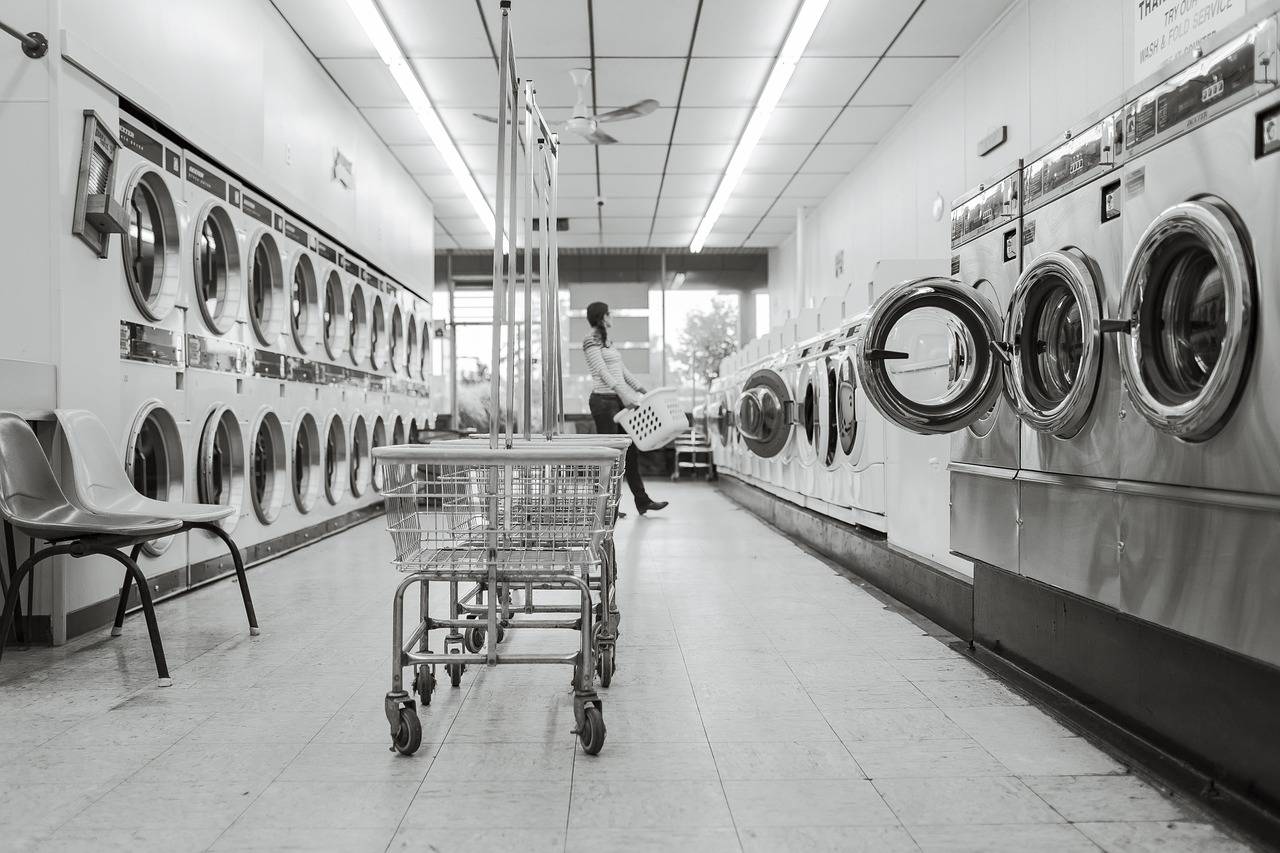Running a laundromat business comes with many expenses, with utility costs being a big one. Almost 70% of owners say high utility costs are their biggest problem. It’s key to understand these costs to keep the business profitable and running long-term.
New laundromat equipment should have monthly utility costs around 15% of gross income. Older machines might see costs rise to about 20%. Laundromats have many ongoing costs, like rent, utilities, insurance, payroll, and supplies. The average monthly cost to run a laundromat is between $4,000 to $8,500. With good management, stores can make around 35% profit each year.
Key Takeaways
- Utility costs, especially electricity bills, are a big worry for laundromat owners, with nearly 70% saying they’re their biggest challenge.
- The ideal monthly utility costs should be around 15% of gross income for newer machines and 20% for older equipment.
- Laundromats face a range of ongoing expenses, including lease/rental costs, utilities, insurance, payroll, and supplies, with the average monthly expenditure falling between $4,000 to $8,500.
- Well-managed laundromats can achieve profit margins around 35% annually.
- Careful management of utility costs is crucial for maintaining competitive pricing and long-term business stability in the laundromat industry.
Understanding Laundromat Utility Expenses Overview
Laundromats have to deal with many utility costs. These include electricity, gas, and water. They can take up a big part of a laundromat’s income, from 65% to 115%. For example, a laundromat making $30,000 a year might see profits between $10,500 and a loss of $4,500, based on these costs.
Common Types of Utility Costs
Laundromat utility expenses usually include:
- Electricity: This powers washing machines, dryers, lights, and more.
- Gas: It fuels heaters, water heaters, and dryers.
- Water: This is for washing machines and other water needs.
Impact on Business Profitability
Utility costs are key to a laundromat’s success. They are often the biggest ongoing cost, after buying equipment and facilities. Keeping these costs low is vital for a laundromat’s health and future.
Average Monthly Expenditure Range
Laundromats spend between $2,000 and $6,000 a month on utilities. This depends on size, location, and more. It shows how important it is to watch and control these costs to stay profitable and competitive.
“Utility costs are one of the biggest ongoing expenses for self-service laundromats, often accounting for a significant portion of their overall operating budget.”
How Much Does Laundromat Electric Bill Cost
Laundromat electric bills can change a lot. This depends on where it’s located, how efficient the equipment is, and how many hours it’s open. Electricity costs usually make up a big part of the $2,000 to $6,000 monthly bills for laundromats.
To stay profitable, laundromat owners should keep their utility costs, like laundromat electricity expenses, between 15-20% of their income. This helps manage energy costs well and keeps the business financially strong.
Buying energy-saving washers and dryers can cut down a laundromat’s average electric bill. Also, using smart energy management, like adjusting hours and using off-peak rates, can lower utility expenses.
“Careful management of laundromat electricity expenses is crucial for maintaining a profitable and sustainable business model.”
Understanding what affects laundromat electricity expenses and using cost-saving methods can help owners control their utility costs. This improves the financial health of their business.
Factors Affecting Monthly Utility Expenses
Managing utility costs is key for a laundromat’s success. Several factors can greatly affect these costs. These include location, equipment efficiency, and operating hours.
Location and Regional Variations
The laundromat’s location can greatly affect its utility costs. Laundromats in cities like Portland, Oregon, face higher rates than those in Wichita, Kansas. Prices for electricity, water, and gas vary by region, leading to big differences in monthly bills.
Equipment Age and Efficiency
The age and efficiency of equipment are crucial for utility costs. Older, less efficient machines use more resources, raising bills. New, efficient equipment can lower costs and boost profits.
Operating Hours Impact
How long a laundromat is open affects its utility use and costs. Longer hours mean more energy and water use, increasing bills. Managing hours can help control costs and improve efficiency.
The size of a laundromat also matters. Larger facilities need more resources for comfort and lighting, affecting costs.
| Utility Cost Factor | Impact on Laundromat Expenses |
|---|---|
| Location and Regional Variations | Higher utility rates in urban areas, lower rates in smaller cities |
| Equipment Age and Efficiency | Older, less efficient machines consume more resources, increasing costs |
| Operating Hours | Longer hours result in greater electricity, heating, cooling, and water usage |
| Facility Size | Larger laundromats (around 2,000 sq ft) require more resources to maintain |
Understanding these factors helps laundromat owners make better decisions. They can reduce expenses and boost profits by optimizing operations.
Breaking Down Monthly Operating Costs
Running a laundromat well means managing monthly costs carefully. These costs change based on location, size, and how you run the business. Knowing what typical costs are helps keep profits up and makes smart financial choices.
Rent or lease costs can be from $2,000 to $10,000 a month. Places in cities usually cost more. Utility expenses, like water and electricity, can be $2,000 to $6,000 a month. This is a big part of the budget.
Other big costs include:
- Equipment maintenance ($500 to $2,000 a month)
- Insurance ($83 to $250 a month)
- Marketing ($500 to $1,000 a month)
- Employee wages (from $2,000 to $10,000 or more, based on size)
- Laundry supplies ($500 to $1,500 a month)
Adding these up, a laundromat’s monthly costs can be $4,000 to $8,500. Keeping these costs in check is key to a successful business.
“Staying on top of monthly operational costs is key to the long-term success of a laundromat business. Regularly reviewing and optimizing these expenses can make a significant difference in profitability.”
Understanding laundromat expenses helps owners make better choices. It lets them find ways to save money and keep their business strong and stable.
Calculating Utility Costs as Percentage of Income
For laundromat owners, keeping costs low is essential. It’s important to know how much utility costs are compared to income. Experts say utility costs, like electricity and water, should be 15% to 20% of monthly income.
Ideal Ratios for New Machines
Laundromats with new, energy-saving machines should aim for 15% of monthly income for utility costs. This balance helps keep profits high and costs in check.
Benchmarks for Older Equipment
Older machines use more energy, raising utility costs. For these, 20% of monthly income for utilities is okay. If costs go over, it might be time to update or adjust prices to stay profitable.
| Utility Cost Ratio | Machine Efficiency | Income Percentage |
|---|---|---|
| 15% | New, Energy-Efficient | Ideal |
| 20% | Older, Less Efficient | Acceptable |
Keeping an eye on utility costs helps laundromats stay profitable and sustainable.
Energy-Efficient Equipment Investment Benefits
Buying energy-efficient laundry machines can cut down on utility costs for laundromat owners over time. Although they cost more upfront, they save a lot on electricity and water bills. This helps pay back the initial cost.
As utility and business costs keep going up, energy-efficient upgrades are key to keeping profits high. Energy-saving washers and dryers can cut water and energy use by up to 30%. This means big savings on monthly bills.
- Tankless water heaters save a lot of energy by avoiding heat loss from traditional tank heaters.
- Buying detergents and supplies in bulk can lower costs per item.
- Using software to manage machines can reduce downtime and boost performance.
By choosing energy-efficient gear and smart software, laundromat owners can increase earnings and run their business better. This also makes their place more appealing to customers who care about the environment. It helps grow the business.
“Energy-efficient laundromat equipment can attract eco-conscious customers, enhancing the laundromat’s reputation.”
In the end, investing in energy-saving laundry machines and other cost-cutting steps offers long-term gains. It’s a smart move that boosts a laundromat’s success and sustainability in a tough market.

Strategies for Reducing Electric Bills
As a laundromat owner, it’s key to keep utility costs low. One way to do this is through peak hours management. Encourage customers to use machines when rates are lower. This can greatly reduce your energy use and costs.
Another important step is equipment maintenance. Regular checks and services keep your machines running well. This means less energy waste. Tasks like cleaning lint traps and adjusting temperature settings help a lot.
- Use energy-efficient lights to cut down on electricity use.
- Make sure your HVAC system works well without using too much energy.
- Teach customers how to save energy, like washing full loads and air drying clothes.
By following these energy-saving tips, you can lower your laundromat’s electric bills. Keeping an eye on peak hour usage and maintaining your equipment are key steps.
Utility Cost Management Solutions
Managing utility costs is key for laundromat owners to stay profitable. Luckily, there are many ways to cut down on these expenses. One good strategy is to work with companies like Global Energy. They can get you better deals on utilities.
These companies look at your current bills and get quotes from different suppliers. They use their knowledge and connections to find you the best rates. This can lead to big savings on your monthly bills.
Some utility companies also have special programs for small businesses. These can include grants or discounts. By looking into these options, you can save even more on your utility costs. This helps make your laundromat more financially stable.
| Utility Cost Management Solutions | Benefits |
|---|---|
| Partner with utility cost management companies | Negotiate better rates, identify cost-saving opportunities |
| Leverage utility company programs and discounts | Access specialized initiatives for small businesses |
| Implement energy-efficient equipment and practices | Reduce energy consumption and lower monthly utility bills |
By using these utility cost management solutions, laundromat owners can save money. This helps improve their profits and makes their business more sustainable.
Pricing Structure Adjustments for Utility Costs
Utility costs are going up, and smart laundromat owners are finding ways to deal with it. They’re charging more for hot water to save on gas. This makes customers choose cold water, which cuts down on costs.
Another good move is to charge more during busy times. This way, owners can make more money and use less energy. It’s a win-win for both the business and the planet.
Laundromat owners can also try different pricing plans. They might charge more for bigger machines or offer special deals. These changes help them stay competitive and keep costs down.
By keeping an eye on prices and adjusting them as needed, laundromat owners can stay profitable. This is good for their business and for their customers.
Hot Water Usage Pricing
Charging more for hot water is a smart move. It encourages people to use less energy. This helps the business save money and promotes green practices.
Peak Time Pricing Strategies
Laundromat owners can use peak time pricing to save on costs. By charging more when it’s busy, they can get people to come during slower times. This reduces energy use and helps the business run smoothly.

“Over 50% of laundromat owners state that high utility bills are their biggest business obstacle, according to Speed Queen.”
Working with Utility Companies
As a laundromat owner, working closely with utility companies can lead to big savings. Many providers have special deals for small businesses like laundromats. By negotiating better rates or joining energy-saving programs, owners can cut down on monthly bills.
It’s important to always check and compare offers from different providers. This helps laundromat owners find the best deals and save money. Keeping in touch with utility companies and knowing the latest news can help owners manage their utility company negotiations and energy provider partnerships well.
Laundromat owners should also look into new ways to save money. For example, using energy-efficient machines can use less electricity. This can lead to big savings on utility bills.
“By proactively working with utility companies and exploring cost-saving strategies, laundromat owners can gain a competitive edge and improve their overall profitability.”
Managing utility costs well is key for a laundromat’s success. This includes utility company negotiations, energy provider partnerships, and smart cost reduction programs. A good plan can make a laundromat more financially stable and sustainable in the long run.
Comparing Costs Across Different Locations
Location is key when running a laundromat. It affects your utility costs a lot. Knowing the regional cost variations helps in choosing the right laundromat site and managing location-based expenses.
Urban areas usually have higher utility rates than rural ones. Local climate, energy markets, and water availability play big roles. For example, laundromats in the West might pay $3.35 per cycle, while those in the South pay about $2.94.
Using energy-efficient equipment also varies by region. In the Midwest, 35% of laundromats use full-cycle drying. But in the South and West, only 11% do. These differences can greatly affect your costs and profits.
| Region | 18-24 lb Washer Cycle Cost | Full-Cycle Drying Adoption |
|---|---|---|
| West | $3.35 | 11% |
| Midwest | $3.07 (National Average) | 35% |
| South | $2.94 | 11% |
When picking a location for a new laundromat or checking an existing one, consider regional variations in utility expenses. This knowledge helps in setting prices, choosing equipment, and planning for profits.
Conclusion
Managing utility costs is key to a laundromat’s success. Knowing how electric bills are affected by location, equipment, and hours helps owners. They can then find ways to cut costs.
Buying energy-efficient machines and keeping them in good shape are smart moves. Owners can also adjust prices to balance out higher costs. This keeps profits steady.
Keeping up with local utility programs and working with companies can lead to savings. By managing costs well, owners can focus on making customers happy and finding new ways to make money. This boosts laundromat profitability and keeps the business strong.






